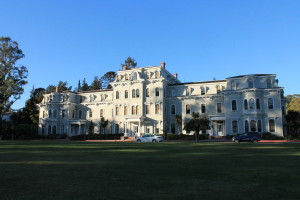
Juniors Imani Karpowich Smith and Xiomara Hooker are faced with difficulties as they try to carry on the historical publication, The Womanist, A Women of Color Journal at Mills.
With no current students on the editorial board, no advisor to take the previous advisor’s place, and no funding due to a lack of communication, the future of The Womanist is uncertain.
The Womanist, which grew out of the ethnic studies department, was founded in 1992 as a publication featuring writers and artists of color at Mills. It was created in order to put students of color’s voices at Mills in the foreground. The Womanist is published annually, and is put together by an editorial board of Mills students and alumni. The publication accepts submissions from students, faculty, staff and alumni of color.
Mills alumna Stephanie Der was a member of The Womanist for three years, working as a general member and Managing Editor. Der believes that working on The Womanist can allow students to change an industry that is overwhelmingly white.
“The Womanist provides a space where artists of color can be themselves without being asked to ‘whiten’ or ‘extra exotify’ their work,” Der said. “By joining the staff or submitting work, we can plant the seeds to revolutionize the publishing industry.”
Der enjoyed being able to share the works of students and staff of color that might not have otherwise been seen.
“I remember I saw [contributor] Veronica Perry at the launch party, and she told me she’d been surprised her piece had been chosen for the cover since the piece just sat in the back of her closet,” Der said. “It’s such a gorgeous piece, and I’m thrilled I was able to help work like that literally come out of the closet.”
Both Hooker and Karpowich Smith wanted to submit work to The Womanist this year, but found that there was no current group on campus yet.
“It hasn’t necessarily gone away,” Karpowich Smith said. “But because all of the previous editorial board members graduated, there wasn’t really a passing down the torch.”
After discovering that there was no current editorial board, and that the publication could not continue without one, Hooker and Karpowich Smith started working to get a group together.
“Initially I just wanted to submit something,” Hooker said. “But then I found out that there was no staff on it, so I wanted to help out and get it established.”
Hooker is determined to help The Womanist continue, and believes that this publication has an important place on campus.
“Looking at The Walrus and things like that, it’s very monolithic in the sense that it’s white writers on campus,” Hooker said. “I want The Womanist to be a space where students of color feel like they have a publication where they can showcase their voices.”
The publication was also unable to submit a request for funding in the previous year, so now it will receive no funding in Fall 2016. Alumnae Dajanae Barrows was the editor-in-chief from 2014-2015, and experienced a lack of communication regarding the request for funding.

“The Womanist did not put in a request for funding for Fall 2016 due to the lack of communication between myself, ASMC and those involved with maintaining our budget,” Barrows said. “We had no idea that we were even called for a meeting or for a request in the first place, let alone any meeting at all.”
Although the publication will not be allocated funding for Fall 2016, ASMC president Erin Clark believes that there is a possibility that The Womanist could be funded for Spring 2017.
“The funding The Womanist would receive would depend on what was requested in a special funding hearing, or an application to restart the organization,” Clark said. “Should it start back up, it would have to put in a request for special funding to receive ASMC funds for it, or re-apply as an organization/club next semester.”
Along with lack of student interest and funding, there is also no faculty advisor yet. Associate Provost Chinyere Oparah was the previous advisor for The Womanist, but is unable to continue due to a lack of time. Oparah has watched The Womanist evolve over time and change as Mills has continued to change.
“In the last edition of The Womanist ,there was intentionality about including transgender and genderfluid voices and experiences, because when it was designed as a woman of color journal, there wasn’t such understanding of a complexity of gender,” Oparah said. “Updating it meant creating a space where all of our students could really feel that they could have a voice.”
Although The Womanist usually gets started earlier in the semester, Oparah believes that there is still time for the publication to produce an edition this year.
“It’s a little late, but there have been years when it started in October, and they’ve successfully produced the edition,” Oparah said. “There’s absolutely time for people to come together and form an editorial board and make an awesome edition of The Womanist.”




